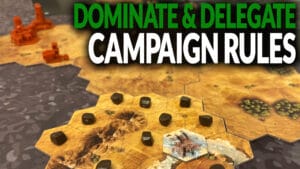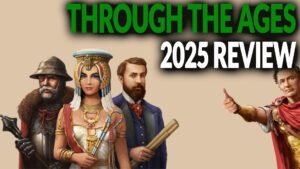What happens when Command & Conquer jumps off the screen and lands on your tabletop, armed to the teeth with fog-of-war mechanics, hidden production queues, and a battlefield crawling with secrets? Welcome to the Skirmish Mode of Dominate & Delegate, where tactical ambition meets explosive multiplayer showdowns.
Game Setup
To set up the game, each player receives:
- 1 player table
- 1 production queue
- 1 handheld
- 1 infantry Box
- 1 figure box, containing 1 orbital strike token and all remaining faction figures listed on the respective player table
The setup of the game board depends on the respective skirmish mission.

Definitions & Characteristics
Gameboard
In skirmish mode, battles take place on a hex-based outdoor board, each with unique terrain effects. Free spaces like meadows and deserts allow free movement. Water and mountain spaces block buildings and ground units. Forests on the other hand are more tactical: buildings are allowed, and ground units can enter but must stop immediately. Units marked “not in forest” can’t enter forests at all.
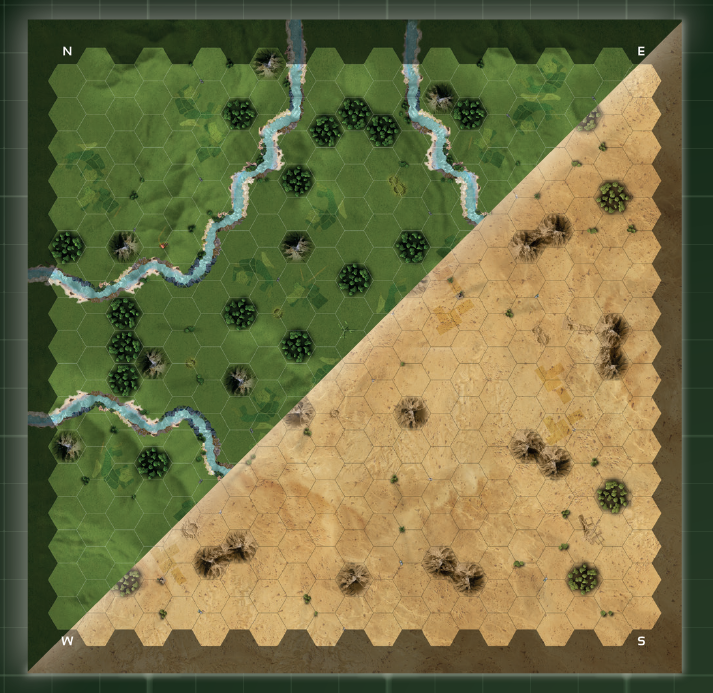
Figures
In Dominate & Delegate, a figure is defined a all plastic models, except ore, and a few tokens, such as: MCV, Helipad, Construction Yard, APC, Civilian, Boar and Stealth Vehicle.
‘Units’ are all non-building figures. This means air units and ground units, which can be further subdivided into infantry, wheeled vehicles and armored vehicles. There is one exception: Fighters and bombers on a Helipad are considered as wheeled vehicles. Dropship air units on the other hand count as air units even if they are on a helipad.
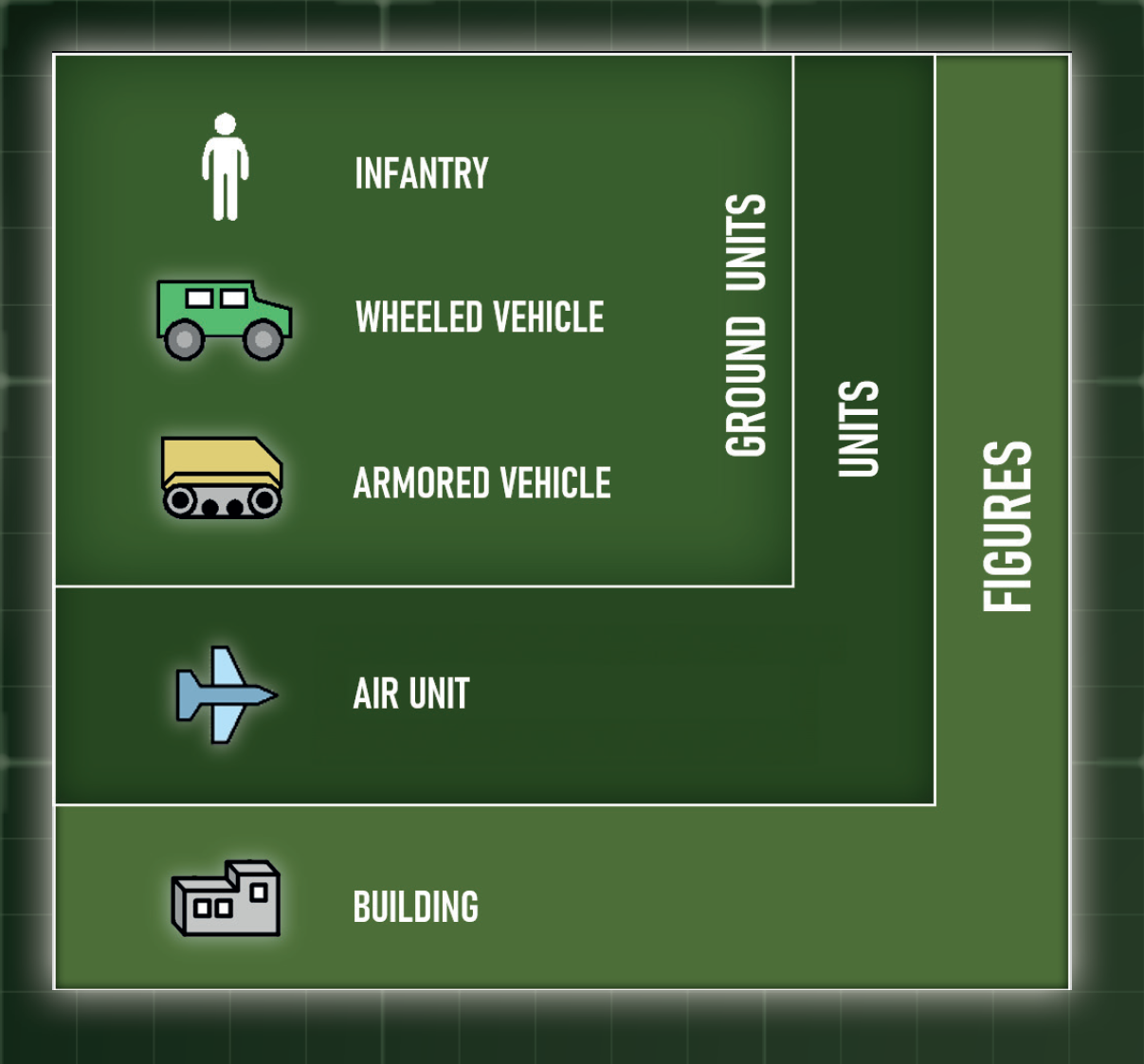
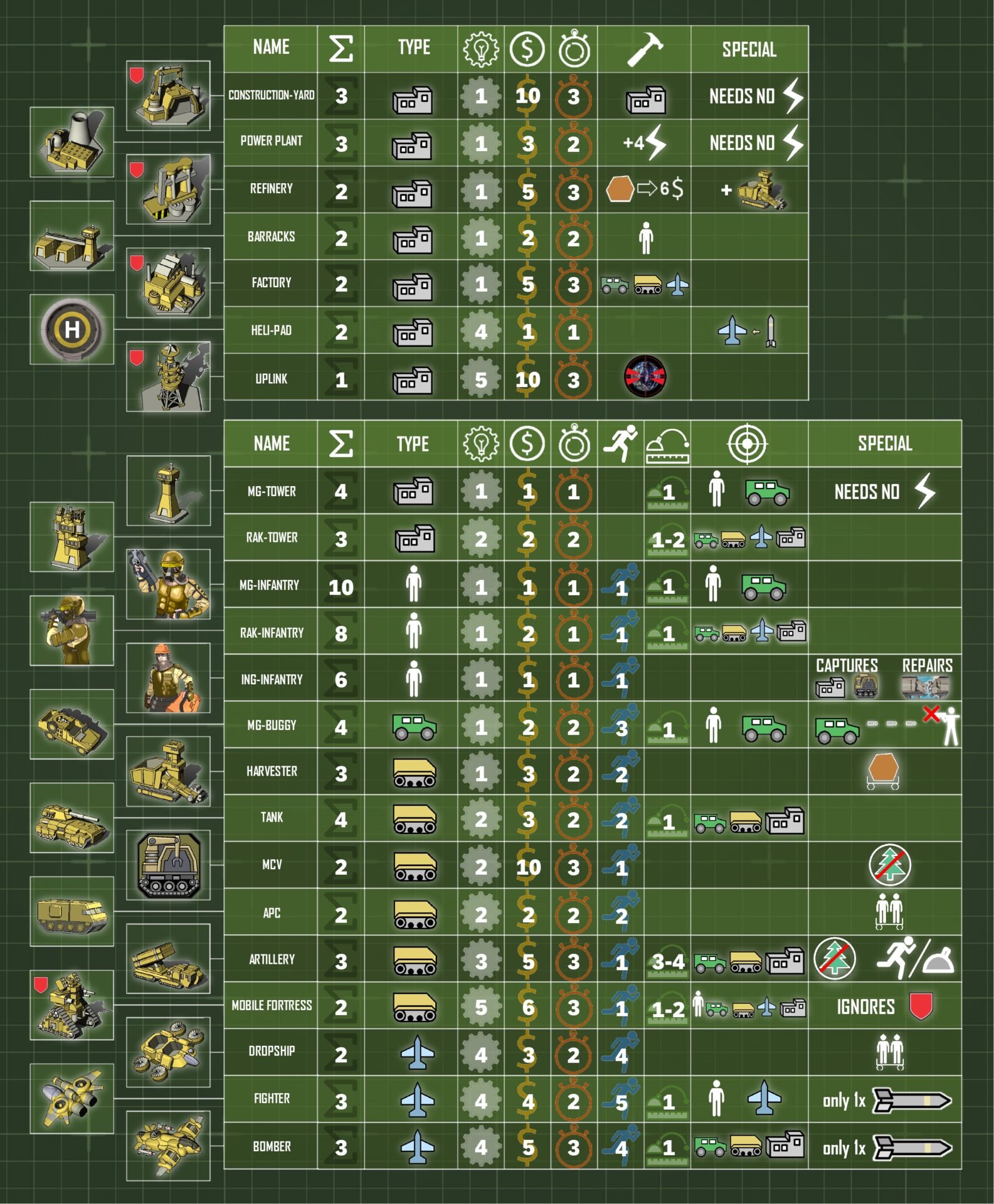
Handheld
Another important game element is the handheld. Players use it to track their energy and credits.
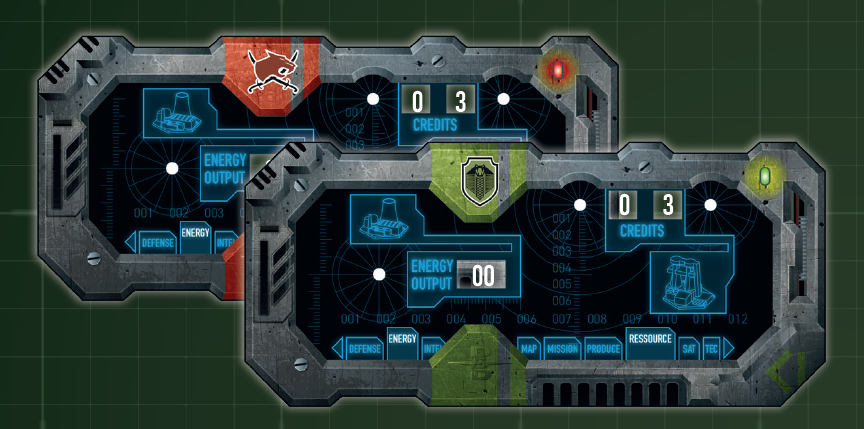
Energy
You as a player should always make sure you have enough energy to remain capable of acting.
The available energy is calculated based on your buildings and must be recorded on your handheld all the time. Each power plant provides 4 energy, each other building costs 1 energy. Contruction yards, power-plants and MG-towers cost no energy.
If you capture a power plant, the capturing player receives the energy and the other player has to reduce his energy on the handheld.
If your available energy is less than 0, only power-plants are moved forward in the production queue, air unit weapons are no longer charged, RAK towers can no longer attack and refineries cannot convert ore into credits.
Objective & End
As a player, your goal is to destroy all of your opponent’s pieces or force him to give up. There may be stalemates, in which case the game ends in a draw.
Gameplay
Round & Player Turn
Introduction
A round involves one turn per player, clockwise, and goes through two phases: the activation phase and the production phase.
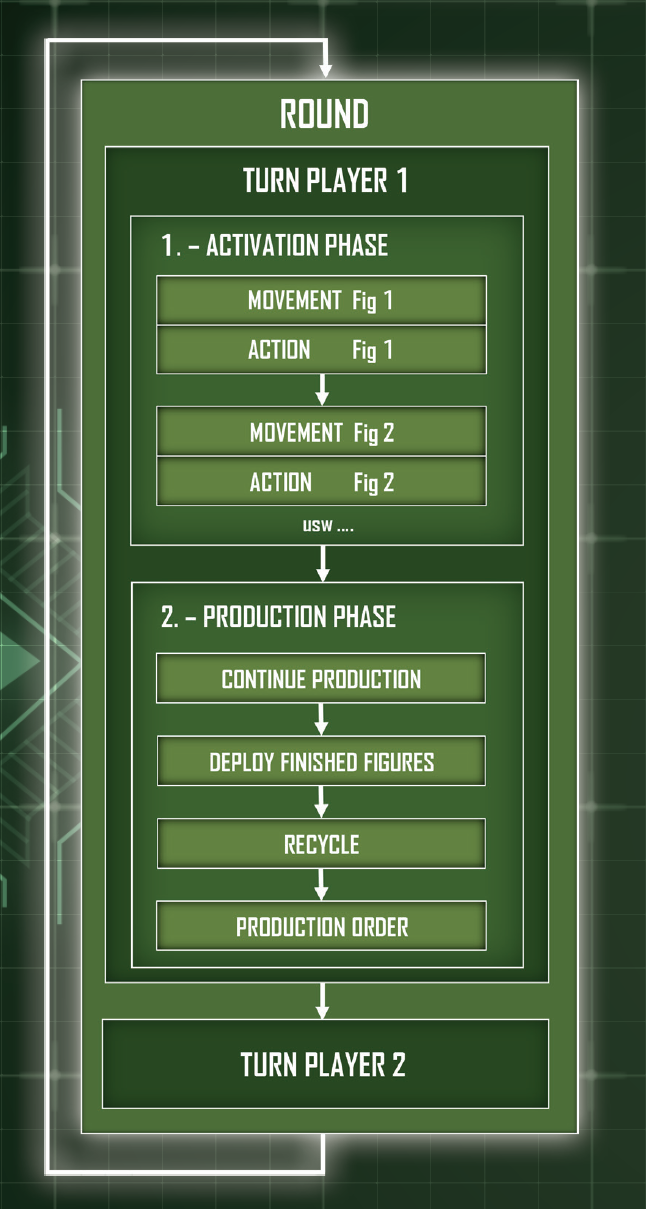
Activation Phase
Introduction
During the activation phase you activate your figures one after the other and may move them first and then may perform an action with them.
Be aware that some figures cannot do both.
Movement
It’s obvious, but only units can move, not buildings. The speed of each unit is determined by your player table. Each figure can move one space per speed.
In general, ground units must not be placed, set up or moved through enemies, buildings, water and mountains. The only exception are armored vehicles that can run over infantry. However, it’s always possible to move through friendly or neutral units.
Air units may move across all spaces but must end their movement on a free space or helipad.
There are a couple of important rules that must be respected when moving:
- 2 figures generally cannot be on the same space, except for a single unit with one ore.
- As already explained, most units may enter the forest but may not leave it in the same turn.
- An ING-infantry is allowed to capture an adjacent building or MCV. If this happens, the infantry must be removed and the other player’s figure replaced with one of the capturing player.
- An infantry can move into an adjacent transport unit or out of one to an adjacent space but then has no further action.
- As already mentioned, armored vehicles can run over infantry. However, this can trigger retaliation. We will also go into this in more detail.
Before we come to the action of the units, a word about the orientation of the units on the game board: Units should always be oriented in the same direction. After activation, turn them in a different direction. In both cases, however, the basic orientation should be away from you, as fighters and bombers are oriented towards you as soon as their weapons are empty.
Action
After moving, your activated figure may perform one action.
Depending on your figure, following actions might be available to you:
- Attacking or suppressing.
- Loading ore from the same space by a harvester.
- Unloading ore on an “unload” space at a friendly refinery. You then receive 6 credits for this action, if sufficient energy is available.
- Repairing a bridge by an ING infantry from an adjacent space.
- Selling a building to receive half of the rounded-up construction costs. For selling a refinery, you only receive 1 credit, as you will keep the harvester.
- Converting of a construction yard into an MCV or vice versa. When this action is perform, be aware of the maximum number of buildings in the production, which will be explained in the production phase.
- Fighters and bombers can use their action to charge their weapons on a helipad if sufficient energy is available. After charging, the figure should be turned away from the player.
Production Phase
Continue Production
If you have enough energy, your entire game material in the hidden “production queue” is moved one space to the left. If you have less than 0 energy, only the power plants may be moved.
Deploy Finished Figures
In this step all your figures on the “Ready” space can be deployed.
Let’s first talk about buildings: Buildings may only be placed on an empty meadow, desert or forest space up to 2 spaces away from the next faction building. MG towers and RAK towers may also be placed further away but do not apply to the deployment area of other buildings.
If a power plant is deployed, your energy level can be increased by 4. If you deploy any other building, your energy must be reduced by 1, unless it is a construction yard or MG-tower which don’t need energy.
If you deploy a refinery, you can also deploy a harvester on the “unload” space of this refinery. If there is any infantry on this space, it will be destroyed but can retaliate.
If you deploy an uplink, the orbital strike token will be placed in production queue slot number 8.
Infantry on the other hand may only be deployed on a space next to the barracks.
Wheeled vehicles, armored vehicles and dropships may only be deployed on two defined spaces next to a factory.
If you deploy ground units, always keep in mind, that they also must be placed on an empty and valid space.
Fighters and bombers may only be deployed on a helipad. As they arrive already charged, their orientation is away from you.
Recycle
In this step, you can cancel current productions by removing elements from your production queue to receive a full refund. In such cases you can add the credits back to the handheld.
Production Order
If you want to produce further figures, this is your step! Therefore you place any number of unused figures secretly in the production queue in the slot according to the production time of the figure. Additionally, the production costs must be paid by reducing the credit value on the handheld.
But of course, there are limits:
- You may only have as many infantries in your production queue, as you have deployed Barracks.
- You may only have as many wheeled vehicles, armored vehicles and air vehicles in total in your production queue, as you have deployed Factories.
- You may only have as many buildings in your production queue, as you have deployed Construction Yards. And don’t forget: As mentioned before, an MCV is not considered a construction yard.
If at any time these requirements cannot be met, the exceeding number of figures must be destroyed. Apart from capturing, the choice is up to the player.
Please be aware that the “ready” slot is part of the production queue. If you want to postpone the deployment, keep the limitations in mind!
Combat
Attack
A figure may use an action in its activation to attack any other figure. It is also permitted to attack the own figures. Which figures can attack which other figures and what range they have is determined by the player table.
Some figures have a shield in the player table or in the mission rules. Such figures can only be destroyed if they are attacked two times during the same player turn.
Destroyed Figures are then removed. If a destroyed harvester was transporting ore, the ore remains on that space.
Retaliation
During an attack, a target Figure immediately may perform retaliation against the attacker during the Attack under the following conditions:
- It’s only possible against the first attacker within the same player turn.
- The attacking figure must not be a figure of the player who wants to retaliate.
- The attacking figure must be a valid target of the target figure, according to the player sheet.
Suppression
Instead of an attack, which may result in retaliation, suppression is also a possible.
If one figure could attack another, it can alternatively use the action to perform a suppression against a target figure. In such cases neither the attacker figure nor the target figure suffers damage but the target figure is not allowed to perform a retaliation in the current player’s turn – even if attacked by another figure afterwards.
Be aware that retaliating or suppressing fighters and bombers unload their weapon and that while they are on a helipad, they are handled like a wheeled vehicle and therefore cannot perform an attack, retaliation or suppression.
Capturing
An ING-Infantry may use its movement to capture an adjacent building or MCV. The ING-Infantry is then removed and the captured building is swapped with the capturing player’s building of the same type. Captured buildings may be sold in the following round at the earliest.
If a factory, a construction yard or a barrack is captured, the capturing player may view the production queue of the other player. If the capturing causes the production queue to exceed the allowed number of figures in production, the capturing player may choose a figure from the production queue and place an own figure of the same type in the same position in his own production queue.
If a refinery is captured, the player take 50% of the Credits of the previous owner. If the refinery is captured while a harvester of the same color is on its unload space, the player also captures that harvester and replace it with his own one.
If a player captures a helipad with a fighter or bomber on it, he also captures that air unit.
However, civilian buildings or special buildings cannot be conquered. If such an action is performed, they are only inspected and might trigger an event. The ING infantry must also be removed in such cases.
When capturing buildings, don’t forget to adjust the energy level on the handhelds.
Special Cases
Bridges
Bridges are buildings and can be entered by ground units like an empty playing field, regardless of the orientation of the token. The player can decide whether to destroy the bridge or the unit on the bridge. If the bridge is destroyed, the ground unit on it is also destroyed.
As long as a bridge is destroyed, you have to treat it like a water space until it is repaired.
Tilted Infantry
In some cases, infantry is tilted. A tilted infantry is inactive and cannot perform movements, attacks, suppressions and retaliations.
The figure can be activated to stand up with no further movement or action.
Walls
And then there are walls. Walls are to be treated as neutral buildings.
Transportation
It’s also possible to transport infantry, as already explained: During the movement phase, an infantry can move into an adjacent transport unit or out of one to an adjacent space but then has no further action. Transported units cannot use any further action, cannot be attacked and are destroyed when the transporter is destroyed.
Uplink & Orbital Strike
If you deploy the uplink, you can place the orbital strike token in the production queue on slot 8.
You can use the uplink’s action to perform one attack on any ground figure, such as buildings or ground units, if your orbital strike token in the ready slot of his production queue. After the attack, the orbital strike token is reset to slot number 8 and moves one slot forward during the building phase.
Missions
The skirmish book contains 18 different missions for 2 to 4 players. Many of the scenarios contain short special rules and triggers that add variety to your games.
However, I would like to mention two types of special rules that are relevant to understand the missions: Triggers and Reward Cards.
Even if triggers play a bigger role in the campaign, they also occur here: Predefined triggers initiate an event. Each trigger consists of the keyword “Trigger”, followed by a short description, the trigger condition, and the effects. In Skirmish mode, the effects are all known in advance – so each player can decide for himself whether he wants to try to set off the trigger.
Reward cards also play a bigger role in the campaign. Nevertheless, players can receive Reward Cards in some missions, which give them advantages for the game. If you discard such a card in order to receive the advantage of the card, you must always discard it faced up, visible to your opponent.






